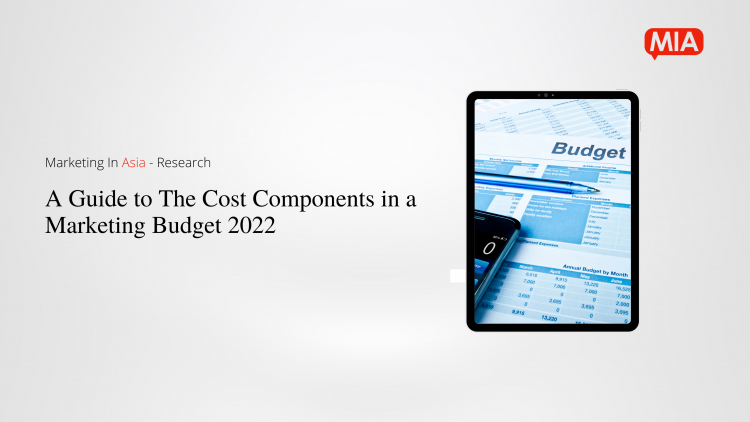What to expect?
- Understanding the components in your marketing budget with the mean budget allocated to each
- Components of the marketing budget
- Marketing Budgets: The Strategic Allocation Model
- Best practices to plan your marketing budget
- Endnotes
Understanding the components in your marketing budget with the mean budget allocated to each
A marketing budget is a foundation for all your marketing decisions. When you have this in place, you can more efficiently generate leads and improve the quality of your brand.
Marketing is a crucial part of any business, and understanding how your marketing budget is allocated can help you improve your marketing strategy. According to research, a new business should issue around 25-35% of its earnings to marketing and promotion. For a B2B firm, this number stands at 13% of company revenue [1]. Marketing In Asia (M.I.A.) data shows that 28% of the budget is allocated for Marketing Technology among the four marketing channels.

Image source: Marketing In Asia research Optimising The Cost Of Digital Marketing For Businesses
Marketing is a vast array of components that, when put together, steers the business in the right direction. Still, most companies are unclear about how to allocate their budget for different marketing components when it comes to the marketing budget. They don’t know how much they should spend on advertising, on-site marketing, etc. Knowing where to channel your money for the best possible outcome is a dynamic marketing problem that keeps changing depending on the need of the business, current market scenario and industry of operation. A recent M.I.A.’s report brings forth the mean percentage of budget allocated across various marketing components, which shows that the top 3 components are performance marketing (11%), followed by digital commerce (10%) and brand strategy, sponsorship, CRO and customers insights, that stands at 8% each. Let us visit each one at a time:
Components of the marketing budget

Image source: MIA research Optimising The Cost Of Digital Marketing For Businesses
1. Market research & competent analysis: Knowing the market you are about to set foot in is mandatory for the right decision making. According to research, the market research market is expected to grow at a compound annual growth rate of 5%, from $75 billion in 2021 to $90.79 billion in 2025 [2]. According to MIA research, an average of 5% of the marketing budget goes into market research.

Image source: MIA research Optimising The Cost Of Digital Marketing For Businesses
2. Digital commerce: Digital commerce accounts for all of the elements of purchase decisions. As per MIA research – Digital Commerce bags an average of 10% of the marketing budget. Typically, digital strategists map the complete consumer journey, whether it’s for a product or a service, establishing how much weight to give each purchase milestone, and designing consumer journeys that deliver a consistent experience for the end-user. Digital commerce features include, but are not limited to:
- Marketing with content
- Descriptions of products, photos, and other media
- Promotional campaigns, social media involvement, and marketing as a function
- Analytics
- User journey mapping
- Customer support
- Supply chain management and order fulfilment
3. Brand strategy: A branding strategy is a long-term plan to develop stickiness for your company/product. It focuses on uniting your brand’s internal and external aspects and clearly documenting your goals. This segment attracts an average of 8% of the marketing budget.
Image source: MIA research Optimising The Cost Of Digital Marketing For Businesses
Also read: MIA’s research report on Best Brand Building Practices.
4. Sponsorship: Another 8% is allocated for sponsorships. Sponsorship involves the in-kind support of people, events, exhibits, groups or causes to promote your business goals and competitive advantage. Sponsorship is different from advertising, which focuses on persuasion and convincing customers to make purchases.

Image source: MIA research Optimising The Cost Of Digital Marketing For Businesses
5. Customer insights: It is all about knowing your customers. Conducting research into customer behaviours to understand better what they want and need gives you a much better understanding of the reasoning behind their feelings and opinions. Our research indicates that companies allocate an average of 6% of the budget for this segment.
6. Content creation: The beauty of content marketing lies in the fact that it costs about 62% less than traditional marketing but is three times more effective than it [3]. As the name suggests, this is where all the content, be it written, audio, video etc., is created, keeping in mind the end audience. Research also shows that 93% of B2B marketers use content marketing for marketing their products or services [4]. An average of 6% of the marketing budget goes into content creation.

Image source: MIA research Optimising The Cost Of Digital Marketing For Businesses
7. Content distribution: This caters to channels of distribution of the content to reach the masses via Owned media, Paid Media and Earned media. An average of 7% of the marketing budget goes onto content distribution.
8. Customer engagement: Customer engagement caters to increasing the stickiness of your customers through different modes of engagement. This segment bags 6% of the marketing budget.

Image source: MIA research Optimising The Cost Of Digital Marketing For Businesses
9. Promotions: Another 6% goes into promotions. Promotions include a wide range of activities that help with attracting and convincing people to buy your product. It’s meant to get people to know about the product, see it or use it – in preference over others.

Image source: MIA research Optimising The Cost Of Digital Marketing For Businesses
10. CRO: Conversion rate optimisation (CRO) is the process of increasing the percentage of conversions from a website or mobile app. An average of 8% of the marketing budget is invested in CRO.

Image source: MIA research Optimising The Cost Of Digital Marketing For Businesses
11. Loyalty programs: Loyalty programs, traditionally offered by businesses, offer rewards, discounts & special incentives to attract and retain customers. Our study indicates that businesses allocate an average of 6% of the budget for loyalty programs.

Image source: MIA research Optimising The Cost Of Digital Marketing For Businesses
12. Demand generation: Demand generation is a common marketing strategy that involves increasing awareness of your products and services, generating urgency, and clarifying your product’s value in the marketplace to attract a customer base. Data indicates that businesses allocate an average of 6% of the budget for demand generation.

Image source: MIA research Optimising The Cost Of Digital Marketing For Businesses
13. Performance marketing & analytics: This segment bags the highest budget allocation at 11% of the marketing budget. Performance marketing is a strategic digital marketing technique that focuses on the entirety of a business by generating results and providing interactivity with customers.
Marketing Budgets: The Strategic Allocation Model
Dividing the marketing budget process into manageable components helps achieve both clarity and alignment Four major sources should drive the allocation of marketing spend: corporate strategy, sales goals, business unit goals and marketing’s own goals Organizations that lack a true campaign strategy will find that a lot of their funds are wasted on disconnected, one-off tactics.

To understand the Marketing Budgets: The Strategic Allocation Model in detail – refer to [5].
Best practices to plan your marketing budget
1. Setting up your SMART goals: It’s a good idea to set your marketing goals first and then develop a strategy for how to reach them. Doing so will help you determine what kind of budget you should have. What do your company’s stakeholders want to accomplish? What is the best planning process for a marketer’s marketing efforts? How long should the marketing plan be, and what should be included? What defines success in terms of goal completion, measurement, and strategy development?
Launching your marketing campaign without goals is like running in the dark. You are bound to fall.
Set clear goals of what you want to achieve through the campaign. One of the most well-known frameworks to help you with that is S.M.A.R.T. goals.

2. Marketing strategy: There are primarily three types of marketing plans: tactical, functional and strategic [6]. A tactical marketing plan is a blueprint of all the marketing activities and initiatives of a company and answers “how” to implement them. On the other hand, functional marketing plans are more specific to a project and are often included in the tactical plan. Strategic plans give marketers a direction. Drafted focusing on a span of 3-5 years, they serve as a roadmap to be followed and how to follow it is dealt with by the tactical plan.
To know more on marketing strategy refer – Five Marketing Moves That Startups Must Not Miss [7].
3. Marketing is an investment: To get the most out of marketing, it’s essential to approach it like an investment. Today many marketers make mistakes by using ROI as a term without also evaluating the return on their investment in marketing. It’s important to keep your marketing efforts consistent and focused on seeing success.
4. Targeting based on behavioural data: A successful marketing plan needs to consider your target audience & be designed to reach them in the right places. You should invest in platforms and channels and understand them inside and out before choosing the best way to get your audience.
5. Building a persistent profile
Marketers enjoy telling stories about their brands; it is the foundation of all they do.
To demonstrate how we talk about identity in digital advertising, I also use storytelling. The film 50 First Dates is a terrific story that helps communicate our story. If you haven’t seen the film, the main character suffers from short-term memory loss and wakes up each day forgetting what happened the day before.
Everything works out in the romcom since it’s a movie, but in marketing, many brands have the same communications with each customer over and over, like a dreadful horror picture.
To avoid this recurrent introduction, marketers need identification solutions that are tied to real individuals, allowing them to build long-term ties. Persistence helps you to continue a dialogue with each person this month, year, next year, and beyond. If your identity solutions rely solely on cookies and device IDs, both of which expire, that history is erased, and the marketer must start over.
6. The bottom-up approach: Moving bottom-up to your marketing can be very beneficial in the long run. You will not only minimise risk but also see additional growth. To help you get leads, begin investing in lead generation, SEO, and Google Ads. These three steps will help maximise your marketing efforts.
7. Measure your efforts: What makes you want to invest in your business? Your marketing budget is essential to the future of your brand. It helps you find out how successful your marketing efforts have been and what areas may need more attention. Marketing ROI is the practice of attributing growth in business revenue to the impact that different types of campaigns have on marketing. It allows you to measure which tactics are most worth pursuing and developing for your business. Marketing ROI is a good justification for future campaigns and initiatives. Understanding the ROI can help in:
a. Justifying the marketing cost
b. Measure and set benchmarks based on the success of the campaigns.
c. Distribute and allocate budgets across various marketing components.
For details on how to calculate ROI, refer to [8].
To know more about marketing budget and ways of cost optimisation download the report.
Endnotes:
- https://www.business2community.com/b2b-marketing/marketing-budgets-are-growing-again-say-cmos-and-marketings-standing-as-well-02397092
- https://blog.hubspot.com/marketing/market-research-buyers-journey-guide?_ga=2.37410915.27990359.1584915918-940436819.156518175
- www.demandmetric.com/content/content-marketing-infographic
- www.iab.net/media/file/B2BResearch2014.pdf
- https://www.marketo.com/analyst-and-other-reports/marketing-budgets-the-strategic-allocation-model/
- https://www.forbes.com/sites/forbesagencycouncil/2017/10/20/how-to-apply-the-best-practices-to-your-marketing-budget-planning/?sh=767b016e6227
- https://startup.marketinginasia.com/five-marketing-moves-that-startups-must-not-miss?utm_source=mia-rr-five-marketing-moves&utm_medium=ln&utm_campaign=smposts
- https://www.marketingevolution.com/marketing-essentials/marketing-roi

















